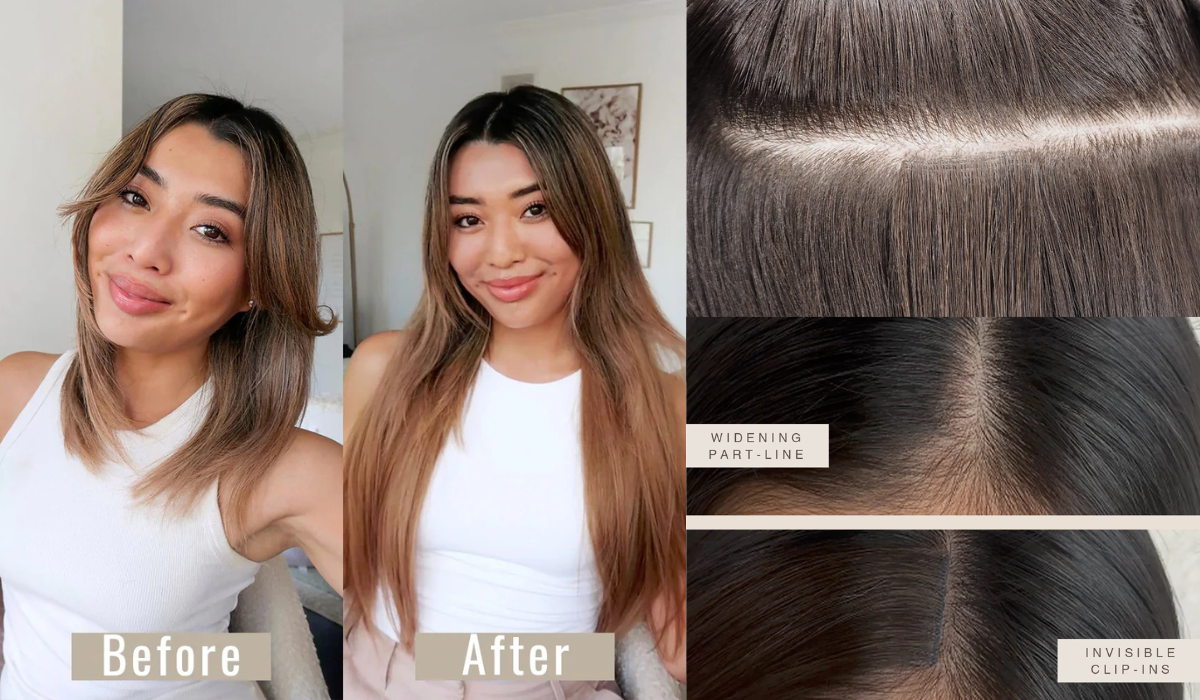If you have thin or fine hair, you know how challenging it can be to achieve volume, texture, and fullness without compromising your hair’s health. Many people with delicate hair dream of thicker, longer strands but worry that traditional extensions might damage or weigh down their natural hair.
That’s where invisible hair extensions for thin hair come in. These innovative extensions are designed to blend seamlessly into your natural strands while remaining undetectable—even up close. They are lightweight, gentle, and ideal for people with thin or fine hair who want to add volume or length without stressing their roots.
This guide will walk you through everything you need to know about invisible extensions: what they are, how they work, how to choose the right ones, and how to care for them properly.
Why Invisible Hair Extensions Are Ideal for Thin Hair
People with thin or fine hair face unique challenges when it comes to extensions:
- Visible Attachments: Traditional extensions, like thick tape-ins or bulky clips, often show through fine strands.
- Weight and Tension: Thin hair can’t support heavy extensions without risking breakage or hair loss.
- Poor Blending: Extensions made from thick or coarse hair may not match fine hair texture, leading to an unnatural look.
Invisible extensions solve these problems by being lightweight, flat, and easy to conceal. Their discreet bases and soft materials make them comfortable and safe for even the most delicate hair types.
What Are Invisible Hair Extensions?
“Invisible” doesn’t mean the extensions are literally invisible—it means that the points of attachment are hidden from view and blend flawlessly into the scalp and hair.
Here’s what makes them special:
- Ultra-thin base: The attachment area (tape, bead, or weft) lies completely flat, so it doesn’t create bumps or visible lines.
- Natural texture and color: Invisible extensions are typically made from fine, soft human hair that closely mimics your natural hair’s texture.
- Lightweight materials: The base and adhesive are minimal, ensuring little to no stress on fragile strands.
- Customizable placement: They can be installed in specific areas where your hair needs volume, such as the crown or sides, without covering your entire head.
There are several popular types of invisible extensions available today, each with unique benefits.
Types of Invisible Hair Extensions for Thin Hair
1. Invisible Tape-In Extensions
These are ultra-thin, transparent tape strips pre-taped with hair extensions. The stylist sandwiches a thin layer of your natural hair between two tape pieces. The result is a flat, seamless bond that lies close to the scalp.
- Pros: Very natural look; quick installation; comfortable to wear.
- Cons: Need regular maintenance every 6–8 weeks as hair grows.
2. Invisible Clip-In Extensions
Clip-ins come with small, lightweight clips attached to hair wefts. Invisible versions use flat silicone or lace bases to make the clips nearly undetectable.
- Pros: Temporary and removable; perfect for occasional wear; no professional installation needed.
- Cons: Should not be worn overnight; may slip if hair is extremely thin.
3. Hand-Tied or Micro Wefts
Hand-tied wefts are made by hand, so they’re thinner and lighter than machine-sewn wefts. They’re installed using small beads or thread, which minimizes tension and bulk.
- Pros: Gentle on the scalp; perfect for fine or thin hair; long-lasting.
- Cons: Requires professional installation; more time-consuming.
4. Nano or Micro-Link Extensions
Tiny beads or rings attach small strands of extension hair to your natural strands. Invisible versions use clear or hair-colored beads for a more seamless appearance.
- Pros: No glue or heat; reusable hair.
- Cons: Not ideal for extremely fragile hair; may require frequent adjustments.
5. Halo Extensions
A halo extension is a single weft attached to a transparent wire that sits like a “halo” around your head. Your natural hair covers the wire completely.
- Pros: Zero damage; quick to apply and remove; great for ultra-fine hair.
- Cons: Not suitable for very short hair; not permanent.
Choosing the Right Invisible Extensions for Thin Hair
Picking the right type of invisible extension is crucial to achieving a natural and safe result. Here’s what to consider:
- Hair Density and Texture – Match the extension thickness to your natural hair. Fine extensions blend best with thin hair.
- Length Goals – Adding extreme length to very fine hair can look unnatural; moderate length and volume usually create the most believable effect.
- Weight – Lightweight extensions are essential. The heavier the hair, the more tension it creates on your roots.
- Attachment Type – Avoid bulky or heat-based methods that can stress fragile strands. Opt for tape-ins, micro wefts, or halos.
- Color Matching – A perfect color blend is key to invisibility. Extensions should match your hair from root to tip or include natural highlights for dimension.
- Stylist Expertise – Always work with a stylist experienced with fine or thinning hair. Correct placement makes all the difference.
How to Apply Invisible Hair Extensions Safely
The application process depends on the type of extension you choose, but for thin hair, some universal guidelines apply:
- Clean Hair: Wash and dry hair thoroughly before installation. Avoid conditioner near the roots so bonds adhere properly.
- Gentle Sectioning: Stylists should take fine, even sections to distribute weight evenly and prevent pulling.
- No Overlapping: Attach extensions in a way that allows your natural hair to move freely between them.
- Avoid Tension: Bonds or tapes should not pull on the scalp; any tightness may indicate improper installation.
- Test a Strand First: If your hair is fragile, try one section first to ensure your scalp tolerates the weight and method.
Maintenance and Aftercare
Thin hair with extensions requires gentle, consistent care. Follow these tips:
- Brush Carefully: Use a soft-bristle or loop brush designed for extensions. Brush from ends upward, holding the roots for support.
- Wash Gently: Use sulfate-free shampoo and lightweight conditioner. Focus shampoo on the scalp and conditioner on the mid-lengths and ends.
- Dry Properly: Pat dry with a towel; avoid vigorous rubbing. Blow-dry on low heat to prevent adhesive or bead slippage.
- Protect from Heat: Always use heat protectant sprays when styling with hot tools.
- Avoid Heavy Products: Oils or serums near the roots can weaken bonds. Apply only from mid-shaft downward.
- Sleep Smart: Tie hair loosely in a braid or ponytail at night and use a silk pillowcase to reduce friction.
- Regular Check-Ups: Visit your stylist for maintenance every 6–8 weeks to adjust or replace extensions as your natural hair grows.
Benefits of Invisible Extensions
- Instantly add natural-looking volume and length.
- Lightweight and comfortable for daily wear.
- Blend perfectly with thin or fine hair textures.
- Cause minimal to no damage when applied correctly.
- Can be styled, colored, and treated like natural hair (if made from human hair).
Possible Drawbacks
- Require consistent maintenance.
- Can be costly depending on method and hair quality.
- Incorrect installation may cause damage or visible bonds.
- Must be treated gently to prevent tangling or slippage.
Are Invisible Hair Extensions Right for You?
If your hair is naturally fine, limp, or thinning and you want a discreet boost in volume or length, invisible extensions are an excellent choice. They provide a fuller, natural look without the harsh effects of bulkier systems.
However, if your hair is extremely fragile or experiencing active shedding, it’s best to strengthen your hair health first before applying any form of extensions. Always consult with a professional stylist who understands the delicate nature of thin hair.
Frequently Asked Questions (FAQs)
Q: What makes invisible extensions “invisible”?
A: The base of these extensions lies flat against the scalp and matches the color of your natural hair, making the attachment nearly undetectable.
Q: Can invisible extensions be used on very thin or fine hair?
A: Yes. They are specifically designed for such hair types, with lightweight materials and minimal strain.
Q: How long do invisible extensions last?
A: Depending on the method, they can last from a few weeks (tape-ins) to several months (wefts or nano links), with regular maintenance.
Q: Do invisible extensions damage natural hair?
A: When applied and cared for correctly, they cause little to no damage. The key is proper installation, gentle care, and timely maintenance.
Q: Can I style my invisible extensions with heat?
A: Yes, if the extensions are made from human hair. Just avoid direct heat on the adhesive or bead area.
Q: How can I make sure the extensions stay hidden?
A: Choose the right shade, ensure proper placement, and avoid overloading your hair with too many wefts. A skilled stylist can help achieve a flawless blend.
Q: Are invisible extensions reusable?
A: Many types, such as tape-ins or micro wefts, can be reused several times with proper care and re-application.
Final Thoughts
Invisible hair extensions are a confidence-boosting solution for people with thin or fine hair. They combine the artistry of hairstyling with modern technology to create seamless, natural, and damage-free results. When selected and applied properly, they blend flawlessly, feel light, and allow you to enjoy thicker, fuller hair every day.
The secret to success lies in three key factors: quality, placement, and care. With these in place, invisible extensions can give your thin hair the volume and vitality you’ve always wanted—without anyone ever knowing your secret.

